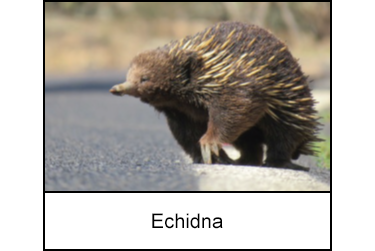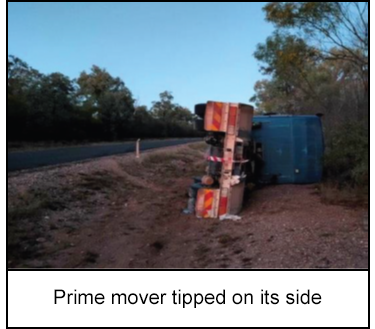-
What happened?
At about 10.00pm, in rainy conditions, the driver of a prime mover braked to avoid some echidnas on the road.
The rear of the prime mover swung around causing the driver to lose control of the vehicle.
As a result, the prime mover rotated through 180°, slid off the left side of the road and tipped onto the driver’s side.
It came to rest approximately 10m (33ft) off the road.
The driver was not injured, got out of the vehicle and activated emergency response protocols.

-
Why did it happen?
To avoid colliding with wildlife, the driver braked suddenly and slightly turned the steering wheel.
The prime mover was configured without a trailer attached.
This reduced the pressure of the tyres on the road and increased the sensitivity of the braking system.
These factors, combined with slippery road conditions due to light rain, made the prime mover more likely to lose traction and more difficult to control (even for the very experienced driver).

-
What did they learn?
Prior to the start of a journey, ensure that an appropriate, value-adding Journey Management Plan is in place.
The Journey Management Plan should address necessary risk factors (e.g. night driving, weather conditions, vehicle weight and configuration).
Take measures to avoid unnecessary driving to reduce driving risk to as low as reasonably practicable (ALARP), including consideration during Journey Management Plans for individual journeys.
Ensure professional driver training includes awareness of techniques to use when approaching wildlife on the road.

-
Ask yourself or your crew
Do you drive at night for work purposes? What can you do to avoid unnecessary driving and/or eliminate the need to drive during high risk periods? Have you been trained in techniques to use when approaching wildlife on the road?
Do you drive a Heavy Vehicle at work? Do you adjust how you drive to account for different vehicle configurations?
Are you using a Journey Management tool to aid in assessing the risks of travel?

Add to homescreen
Content name
Select existing category:
Content name
New collection
Edit collection
What happened?
At about 10.00pm, in rainy conditions, the driver of a prime mover braked to avoid some echidnas on the road.
The rear of the prime mover swung around causing the driver to lose control of the vehicle.
As a result, the prime mover rotated through 180°, slid off the left side of the road and tipped onto the driver’s side.
It came to rest approximately 10m (33ft) off the road.
The driver was not injured, got out of the vehicle and activated emergency response protocols.

Why did it happen?
To avoid colliding with wildlife, the driver braked suddenly and slightly turned the steering wheel.
The prime mover was configured without a trailer attached.
This reduced the pressure of the tyres on the road and increased the sensitivity of the braking system.
These factors, combined with slippery road conditions due to light rain, made the prime mover more likely to lose traction and more difficult to control (even for the very experienced driver).

What did they learn?
Prior to the start of a journey, ensure that an appropriate, value-adding Journey Management Plan is in place.
The Journey Management Plan should address necessary risk factors (e.g. night driving, weather conditions, vehicle weight and configuration).
Take measures to avoid unnecessary driving to reduce driving risk to as low as reasonably practicable (ALARP), including consideration during Journey Management Plans for individual journeys.
Ensure professional driver training includes awareness of techniques to use when approaching wildlife on the road.
Ask yourself or your crew
Do you drive at night for work purposes? What can you do to avoid unnecessary driving and/or eliminate the need to drive during high risk periods? Have you been trained in techniques to use when approaching wildlife on the road?
Do you drive a Heavy Vehicle at work? Do you adjust how you drive to account for different vehicle configurations?
Are you using a Journey Management tool to aid in assessing the risks of travel?
At 10:00pm in rainy conditions, a prime mover driver lost control while braking to avoid echidnas, causing the vehicle to rotate 180°, slide off the road, and tip onto its side. The driver was uninjured and activated emergency response protocols.
Original material courtesy of Safer Together (Australia)
To access the PDF and PowerPoint versions, please visit https://www.safertogether.com.au/resources/sharing-library/driving-loss-of-vehicle-control












